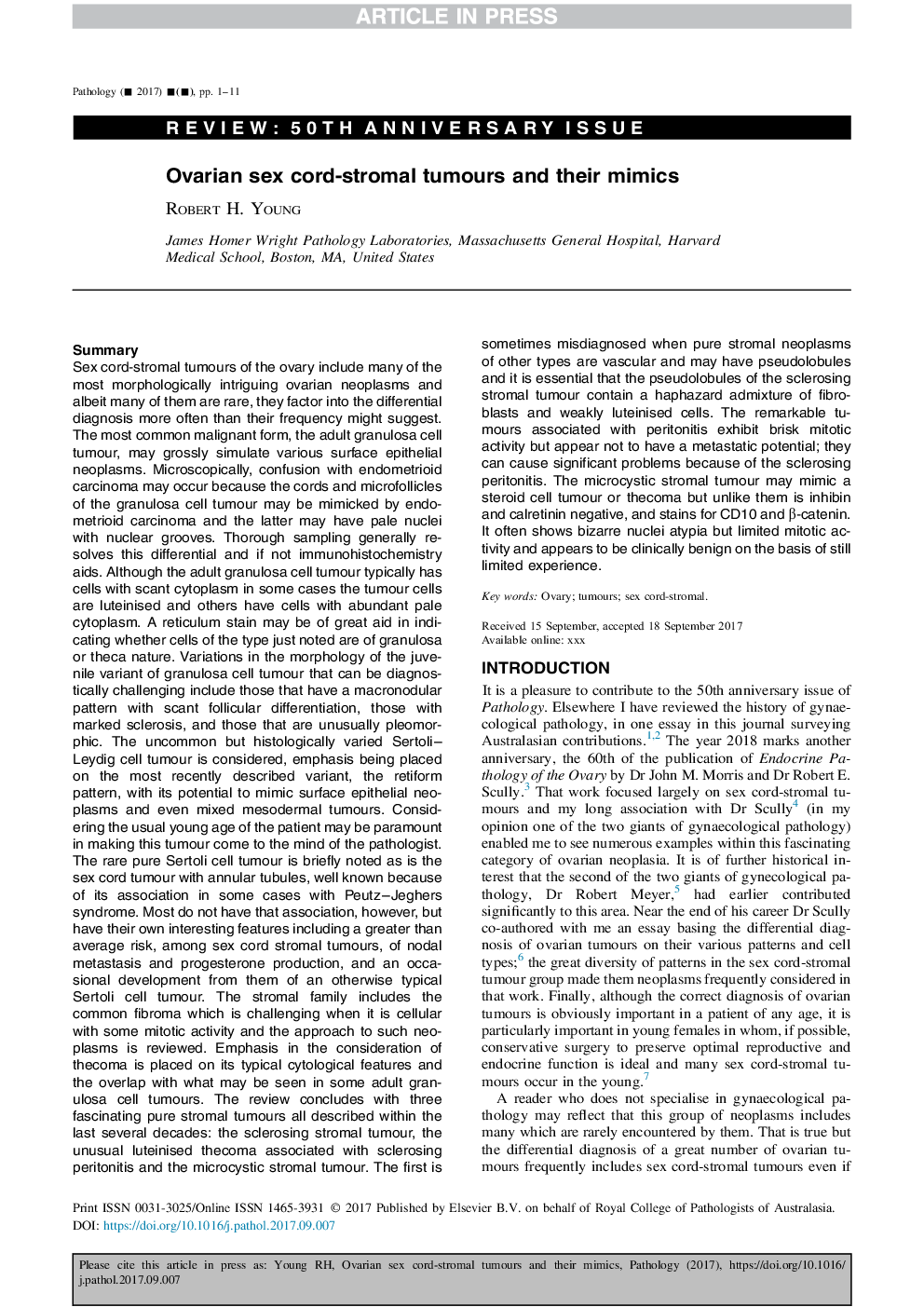| کد مقاله | کد نشریه | سال انتشار | مقاله انگلیسی | نسخه تمام متن |
|---|---|---|---|---|
| 6555573 | 1422486 | 2018 | 11 صفحه PDF | دانلود رایگان |
عنوان انگلیسی مقاله ISI
Ovarian sex cord-stromal tumours and their mimics
ترجمه فارسی عنوان
تومورهای سرطانی استرومال جنس تخمدان و تقلید آنها
دانلود مقاله + سفارش ترجمه
دانلود مقاله ISI انگلیسی
رایگان برای ایرانیان
کلمات کلیدی
تخمدان، تومورها، سینه بند استرومال جنسی
موضوعات مرتبط
علوم پزشکی و سلامت
پزشکی و دندانپزشکی
پزشکی قانونی
چکیده انگلیسی
Sex cord-stromal tumours of the ovary include many of the most morphologically intriguing ovarian neoplasms and albeit many of them are rare, they factor into the differential diagnosis more often than their frequency might suggest. The most common malignant form, the adult granulosa cell tumour, may grossly simulate various surface epithelial neoplasms. Microscopically, confusion with endometrioid carcinoma may occur because the cords and microfollicles of the granulosa cell tumour may be mimicked by endometrioid carcinoma and the latter may have pale nuclei with nuclear grooves. Thorough sampling generally resolves this differential and if not immunohistochemistry aids. Although the adult granulosa cell tumour typically has cells with scant cytoplasm in some cases the tumour cells are luteinised and others have cells with abundant pale cytoplasm. A reticulum stain may be of great aid in indicating whether cells of the type just noted are of granulosa or theca nature. Variations in the morphology of the juvenile variant of granulosa cell tumour that can be diagnostically challenging include those that have a macronodular pattern with scant follicular differentiation, those with marked sclerosis, and those that are unusually pleomorphic. The uncommon but histologically varied Sertoli-Leydig cell tumour is considered, emphasis being placed on the most recently described variant, the retiform pattern, with its potential to mimic surface epithelial neoplasms and even mixed mesodermal tumours. Considering the usual young age of the patient may be paramount in making this tumour come to the mind of the pathologist. The rare pure Sertoli cell tumour is briefly noted as is the sex cord tumour with annular tubules, well known because of its association in some cases with Peutz-Jeghers syndrome. Most do not have that association, however, but have their own interesting features including a greater than average risk, among sex cord stromal tumours, of nodal metastasis and progesterone production, and an occasional development from them of an otherwise typical Sertoli cell tumour. The stromal family includes the common fibroma which is challenging when it is cellular with some mitotic activity and the approach to such neoplasms is reviewed. Emphasis in the consideration of thecoma is placed on its typical cytological features and the overlap with what may be seen in some adult granulosa cell tumours. The review concludes with three fascinating pure stromal tumours all described within the last several decades: the sclerosing stromal tumour, the unusual luteinised thecoma associated with sclerosing peritonitis and the microcystic stromal tumour. The first is sometimes misdiagnosed when pure stromal neoplasms of other types are vascular and may have pseudolobules and it is essential that the pseudolobules of the sclerosing stromal tumour contain a haphazard admixture of fibroblasts and weakly luteinised cells. The remarkable tumours associated with peritonitis exhibit brisk mitotic activity but appear not to have a metastatic potential; they can cause significant problems because of the sclerosing peritonitis. The microcystic stromal tumour may mimic a steroid cell tumour or thecoma but unlike them is inhibin and calretinin negative, and stains for CD10 and β-catenin. It often shows bizarre nuclei atypia but limited mitotic activity and appears to be clinically benign on the basis of still limited experience.
ناشر
Database: Elsevier - ScienceDirect (ساینس دایرکت)
Journal: Pathology - Volume 50, Issue 1, January 2018, Pages 5-15
Journal: Pathology - Volume 50, Issue 1, January 2018, Pages 5-15
نویسندگان
Robert H. Young,
